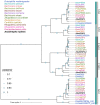Identification of Candidate Chemosensory Gene Families by Head Transcriptomes Analysis in the Mexican Fruit Fly, Anastrepha ludens Loew (Diptera: Tephritidae)
- PMID: 36142444
- PMCID: PMC9500802
- DOI: 10.3390/ijms231810531
Identification of Candidate Chemosensory Gene Families by Head Transcriptomes Analysis in the Mexican Fruit Fly, Anastrepha ludens Loew (Diptera: Tephritidae)
Abstract
Insect chemosensory systems, such as smell and taste, are mediated by chemosensory receptor and non-receptor protein families. In the last decade, many studies have focused on discovering these families in Tephritidae species of agricultural importance. However, to date, there is no information on the Mexican fruit fly Anastrepha ludens Loew, a priority pest of quarantine importance in Mexico and other countries. This work represents the first effort to identify, classify and characterize the six chemosensory gene families by analyzing two head transcriptomes of sexually immature and mature adults of A. ludens from laboratory-reared and wild populations, respectively. We identified 120 chemosensory genes encoding 31 Odorant-Binding Proteins (OBPs), 5 Chemosensory Proteins (CSPs), 2 Sensory Neuron Membrane Proteins (SNMPs), 42 Odorant Receptors (ORs), 17 Ionotropic Receptors (IRs), and 23 Gustatory Receptors (GRs). The 120 described chemosensory proteins of the Mexican fruit fly significantly contribute to the genetic databases of insects, particularly dipterans. Except for some OBPs, this work reports for the first time the repertoire of olfactory proteins for one species of the genus Anastrepha, which provides a further basis for studying the olfactory system in the family Tephritidae, one of the most important for its economic and social impact worldwide.
Keywords: multigene families; olfactory proteins; pest insect; sensorial perception.
Conflict of interest statement
The authors declare no conflict of interest.
Figures







Similar articles
-
Identification and Characterization of Candidate Chemosensory Gene Families from Spodoptera exigua Developmental Transcriptomes.Int J Biol Sci. 2015 Jul 15;11(9):1036-48. doi: 10.7150/ijbs.12020. eCollection 2015. Int J Biol Sci. 2015. PMID: 26221071 Free PMC article.
-
Candidates for chemosensory genes identified in the Chinese citrus fly, Bactrocera minax, through a transcriptomic analysis.BMC Genomics. 2019 Aug 14;20(1):646. doi: 10.1186/s12864-019-6022-5. BMC Genomics. 2019. PMID: 31412763 Free PMC article.
-
Characterization of chemosensory genes in the subterranean pest Gryllotalpa Orientalis based on genome assembly and transcriptome comparison.BMC Genomics. 2025 Jan 14;26(1):33. doi: 10.1186/s12864-025-11217-5. BMC Genomics. 2025. PMID: 39810101 Free PMC article.
-
Recent Advancements in Studies on Chemosensory Mechanisms Underlying Detection of Semiochemicals in Dacini Fruit Flies of Economic Importance (Diptera: Tephritidae).Insects. 2021 Jan 26;12(2):106. doi: 10.3390/insects12020106. Insects. 2021. PMID: 33530622 Free PMC article. Review.
-
The Two Main Olfactory Receptor Families in Drosophila, ORs and IRs: A Comparative Approach.Front Cell Neurosci. 2018 Aug 30;12:253. doi: 10.3389/fncel.2018.00253. eCollection 2018. Front Cell Neurosci. 2018. PMID: 30214396 Free PMC article. Review.
Cited by
-
Identification of candidate chemosensory genes in Bactrocera cucurbitae based on antennal transcriptome analysis.Front Physiol. 2024 Feb 19;15:1354530. doi: 10.3389/fphys.2024.1354530. eCollection 2024. Front Physiol. 2024. PMID: 38440345 Free PMC article.
-
Olfactory Gene Families in Scopula subpunctaria and Candidates for Type-II Sex Pheromone Detection.Int J Mol Sci. 2022 Dec 12;23(24):15775. doi: 10.3390/ijms232415775. Int J Mol Sci. 2022. PMID: 36555416 Free PMC article.
-
Molecular and Functional Characterization of Pheromone Binding Protein 2 from Cyrtotrachelus buqueti (Coleoptera: Curculionidae).Int J Mol Sci. 2023 Nov 29;24(23):16925. doi: 10.3390/ijms242316925. Int J Mol Sci. 2023. PMID: 38069247 Free PMC article.
References
-
- Sachse S., Krieger J. Olfaction in insects—The primary processes of odor recognition and coding. E-Neuroforum. 2011;2:49–60. doi: 10.1007/s13295-011-0020-7. - DOI
-
- Tunstall N.E., Warr C.G. Chemical communication in insects: The peripheral odour coding system of Drosophila melanogaster. Adv. Exp. Med. Biol. 2012;739:59–77. - PubMed
MeSH terms
Substances
LinkOut - more resources
Full Text Sources

